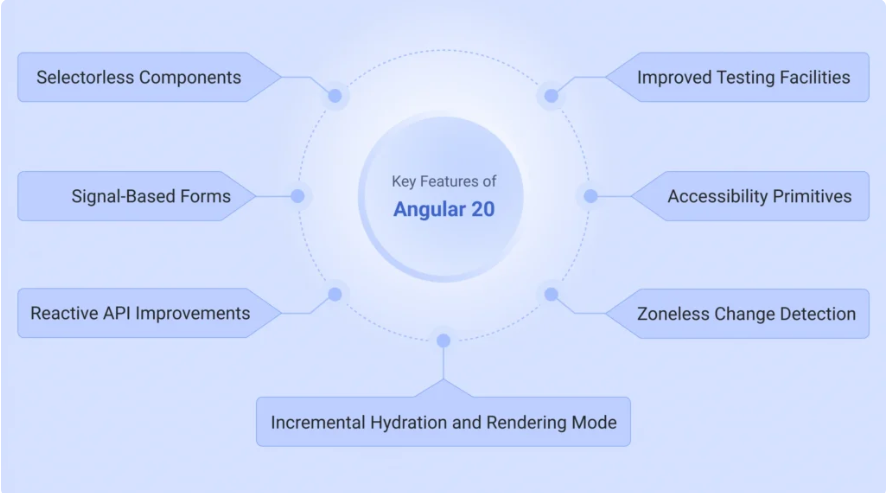Angular 20: Features, Changes, and What’s New

Angular 20 marks a pivotal update in the evolution of Google’s web framework, offering enhanced reactivity, simplified syntax, and performance improvements.
Whether you're building enterprise-scale applications or modern SPAs, Angular 20 empowers developers with a more streamlined and efficient development experience.
Enhanced Template Syntax
Angular 20 brings templates closer to JavaScript, enabling developers to write more expressive and concise code.
- Exponential Operator (
**) – Perform calculations directly in templates. inOperator Support – Check if a property exists in objects directly within templates.- Tagged Template Literals – Use tagged template functions within interpolations.
Benefits:
- Cleaner and more intuitive code
- Less need to push logic into TS files
- Better tooling and syntax highlighting
New Control Flow Blocks: @if and @for
Replacing traditional *ngIf and *ngFor, Angular now introduces:
@if– Includeselsesupport, closer to JS conditionals.@for– Native-like loop structure for easier comprehension.
Why It Matters:
- Improves readability and reduces boilerplate
- Easier for devs migrating from React/Vue
Signals, Effects & Resource API
Signals (Now Stable)
A reactive primitive for managing state:
const counter = signal(0);
function increment() {
counter.set(counter() + 1);
}
- Fine-grained updates
- Replaces many common RxJS cases
- Reduces the need for manual
ChangeDetectorRefuse
Effects API (Stable)
Manage side effects in a reactive, signal-based way.
onCleanup()for safe teardown- Similar to React’s
useEffect
Resource API
- Bridges async logic (like API calls) with signals
- Makes reactive data fetching cleaner and more declarative
Zoneless Angular (Developer Preview)
Angular 20 introduces zoneless change detection, removing Zone.js as a dependency.
- Use
provideZonelessChangeDetection()to opt-in - Manual or signal-based change detection
- Cleaner stack traces and smaller bundles
Not yet production-ready but a glimpse into Angular’s future.
SSR & Hydration Improvements
Angular 20 supercharges server-side rendering:
- Incremental Hydration – Hydrate page sections progressively
- Route-Level Rendering – Fine-grained SSR/pre-render/client strategy
- Event Replay – Ensures UI interactivity after hydration
- Prefetching Parameters – Better multi-page SEO and performance
Benefits:
- SEO improvements
- Faster first-page loads
- Flexible rendering strategies
CLI Enhancements
- New CLI Schematics – Automate migrations to signals,
@if,@for, etc. - Deploy Tooling – Easier deployment to Firebase, Azure, etc.
- Accessibility Warnings – Real-time alerts in dev for a11y best practices
Angular Material & CDK
- Material 3 Tonal Buttons – Brings updated styling options
- CDK Accordion (Experimental) – New primitives for accessible collapsible panels
Selectorless Components
New flexibility for component usage:
- Import components directly without adding selectors
- Works well with standalone components
- Reduces boilerplate and speeds up refactoring
Modernized Testing
- Karma Deprecated – Replaced by:
- Web Test Runner – Native browser testing
- Vitest – Lightning-fast, ESM-ready unit testing
Accessibility & Security Enhancements
- Accessibility Primitives – Community-driven best practices
- CLI A11y Warnings – Get alerts during development
- Stronger Defaults – More secure applications out of the box
Signal-Based Forms (Experimental)
Forms are now reactive-first:
- Built on signals
- Scales better with complex forms
- Enables instant validation via computed signals
Two-Way Binding for Dynamic Components
Angular 20 introduces two-way binding for runtime-created components:
- Great for modals, generators, and dynamic content
- Reduces need for manual output/event handling
Cleanup & Deprecations
- Deprecated:
ng-reflect-*,TestBed.get(),@angular/platform-server/testing - Removed:
InjectFlags - SSR Testing: E2E testing now recommended
Smaller Bundles, Faster Loads
- Aggressive Tree-Shaking
- Optimized Ivy Compiler – Lower memory usage and faster rebuilds
Summary Table: Angular 20 at a Glance
| Feature | Key Benefits |
|---|---|
| Enhanced Template Syntax | Cleaner expressions, JS-style features |
@if, @for Blocks |
More readable control flow in templates |
| Signals API (Stable) | Granular, fast reactivity without RxJS |
| Effects & Resource API | Reactive side-effects and async state |
| Zoneless Change Detection (Preview) | No Zone.js, manual/signal detection, perf boost |
| SSR & Hydration | Incremental hydration, event replay, route-level modes |
| CLI Improvements | Migration tooling, a11y alerts, simplified deploy |
| Material & CDK | Material 3 updates, new accordion primitive |
| Selectorless Components | Cleaner imports, better standalone support |
| Modern Testing | Goodbye Karma, hello Vitest and Web Test Runner |
| Accessibility & Security | A11y primitives and hardened security defaults |
| Signal-Based Forms (Experimental) | Real-time, reactive forms with signals |
| Two-Way Binding for Dynamic Comps | Easy communication for dynamic UIs |
| Deprecations & Cleanup | Legacy APIs removed, cleaner testing practices |
| Smaller Bundles | Faster loads, less memory, smaller builds |
Conclusion: Why You Should Upgrade to Angular 20
Angular 20 is a leap forward. With the introduction of signals, cleaner templates, and zoneless rendering, Angular evolves into a more modern, reactive, and performant framework.
Who Benefits Most:
- Developers: Simpler, less repetitive code
- Teams: Better DX, toolchain, and maintainability
- Enterprises: Performance, security, scalability
How to Upgrade
Use the Angular CLI:
ng update @angular/cli @angular/core
Follow official update guides for step-by-step instructions and compatibility tips.